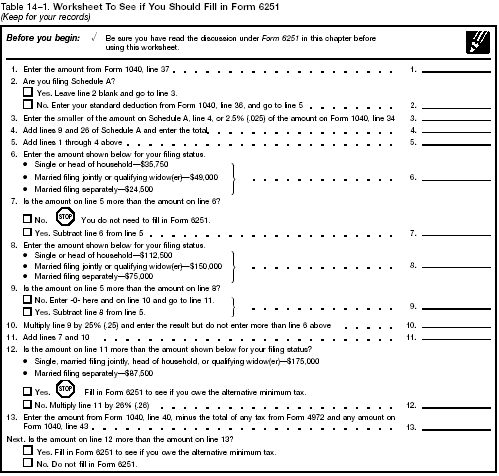14. Alternative Minimum Tax
Introduction
The tax laws give special treatment to some types of income, allow special deductions
for some types of expenses, and allow credits for certain taxpayers. These laws enable
some taxpayers with substantial economic income to significantly reduce their regular tax.
The alternative minimum tax (AMT) ensures that these taxpayers pay at least a minimum
amount of tax on their economic income.
This chapter discusses the AMT for individuals. For information about the AMT for
corporations, see Publication 542, Corporations.
Topics
This chapter discusses:
- Form 6251
- Records you must keep
- Credit for prior year minimum tax
Useful Items
You may want to see:
Form (and Instructions)
- 1040 U.S. Individual Income Tax Return
- Sch A (Form 1040) Itemized Deductions
- 6251 Alternative Minimum Tax - Individuals
- 8801 Credit For Prior Year Minimum Tax - Individuals, Estates, and Trusts
See chapter 21 for information about getting publications and forms.
Form 6251
Individuals use Form 6251 to figure their AMT. They also use
the form to figure certain credit limitations.
Figuring AMT. Use the worksheet in Table 14-1 to see if you
should fill in Form 6251 to figure the amount, if any, of your AMT.
Exception. Fill in Form 6251 instead of using the worksheet
if you claimed or received any of the following items.
- Accelerated depreciation.
- Income or (loss) from tax-shelter farm activities or passive activities.
- Net operating loss deduction.
- Stock by exercising an incentive stock option and you did not dispose of the stock in
the same year.
- Tax-exempt interest from private activity bonds.
- Intangible drilling, circulation, research, experimental, or mining costs.
- Amortization of pollution-control facilities or depletion.
- Percentage-of-completion income from long-term contracts.
- Interest paid on a home mortgage not used to buy, build, or
substantially improve your home.
- Investment interest expense reported on Form 4952.
- AMT adjustments from an estate, trust, electing large partnership, or
a cooperative.
- Section 1202 exclusion.
After you fill in Form 6251, see Who Must File in the form instructions to see if
you need to attach it to your tax return.
Child under age 14. Fill in Form 6251 for a child under age
14 if the child's adjusted gross income from Form 1040, line 35, exceeds the child's
earned income by more than $5,500.
Figuring credit limitations. Although you may not owe AMT, you
generally must still figure your tentative minimum tax on Form 6251 to figure certain
credits. Fill in Form 6251 if you claim any of the following credits.
- Any general business credit
(see chapter 9).
- The qualified electric vehicle credit
(see chapter 12 in Publication 535).
- The nonconventional source fuel credit (see section 29 of the Internal Revenue Code).
- The credit for prior year minimum tax (discussed later).
After you fill in Form 6251, attach it to your tax return.
Records You
Must Keep
 Due
to AMT adjustments, you may have a different AMT basis in certain property or activities.
Because your AMT basis may affect the computation of AMT in future tax years, you may need
to figure the adjustments that affect basis, even though you do not owe AMT this year. You
should keep a separate record of your AMT adjusted basis, including an AMT depreciation
schedule. Due
to AMT adjustments, you may have a different AMT basis in certain property or activities.
Because your AMT basis may affect the computation of AMT in future tax years, you may need
to figure the adjustments that affect basis, even though you do not owe AMT this year. You
should keep a separate record of your AMT adjusted basis, including an AMT depreciation
schedule.
Carrybacks and carryovers of certain deductions and credits may have to be refigured
for AMT purposes. You should keep a separate record of these AMT carrybacks and carryovers
to assist you in preparing your return in other years.
Credit for Prior Year Minimum Tax
Individuals use Form 8801 to figure their minimum tax credit, if any,
for AMT incurred in prior tax years. They also use the form to figure any minimum
tax credit carryforward.
Form 8801. Fill in Form 8801
if you had any of the following items in 2001.
- An AMT liability and adjustments or preferences that do not cause a permanent difference
in taxable income over time.
- A minimum tax credit carryforward.
- An unallowed nonconventional source fuel credit or qualified electric vehicle credit.
For more information, see Form 8801.
Reduction for canceled debt. You
may have to reduce the credit if you exclude from income a canceled debt from any of the
following.
- A bankruptcy case.
- Insolvency.
- Qualified farm debt.
You must reduce the amount available at the beginning of the year after the debt was
canceled before preparing Form 8801 for that year. For more information, see Cancellation
of Debt in chapter 4.

Table 14–1
- Continue - |